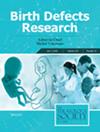Association Between Socioeconomic Status and Major Congenital Anomalies: A Two-Sample Mendelian Randomization Study
Abstract
Background
Traditional observational studies suggest that socioeconomic status (SES) may influence the risk of congenital anomalies; however, an association remains unclear due to residual confounding. This study used Mendelian randomization (MR) to explore the potential causal relationship between SES indicators and specific congenital anomalies.
Methods
We performed two-sample MR analyses to explore whether three indicators of SES—educational attainment, household income, and the Townsend Deprivation Index—have a relationship with the risk of major congenital anomalies. Genetic variants associated with these SES indicators were obtained from the MRC Integrative Epidemiology Unit (IEU) OpenGWAS database, based on UK Biobank data. Genetic associations with nine categories of congenital anomalies were sourced from the FinnGen study. The primary MR method was inverse-variance weighted (IVW), with sensitivity analyses and Bonferroni correction applied to account for multiple testing.
Results
Prior to correction for multiple testing, higher educational attainment was associated with reduced risk of congenital heart defects (CHDs) (OR = 0.60, 95% CI: 0.41–0.88; p = 0.001), congenital respiratory system malformations (OR = 0.20, 95% CI: 0.06–0.62; p = 0.005), and musculoskeletal malformations (OR = 0.47, 95% CI: 0.29–0.76; p = 0.002). A lower Townsend Deprivation Index was unexpectedly associated with a higher risk of congenital digestive tract anomalies (OR = 4.53, 95% CI: 1.10–18.63; p = 0.036). However, after Bonferroni correction, only the association between educational attainment and CHDs remained significant (adjusted p = 0.02).
Conclusions
We found limited evidence on the association between SES and congenital anomalies. Only higher educational attainment was significantly associated with reduced risk of CHDs after multiple testing correction. Further research with refined methods is needed to clarify these associations.

 求助内容:
求助内容: 应助结果提醒方式:
应助结果提醒方式:


